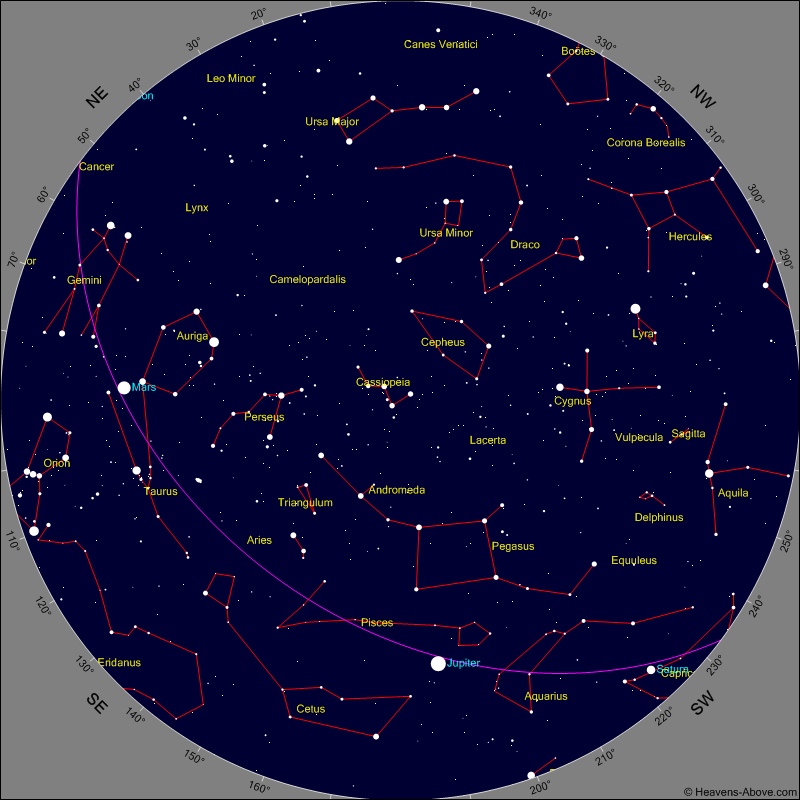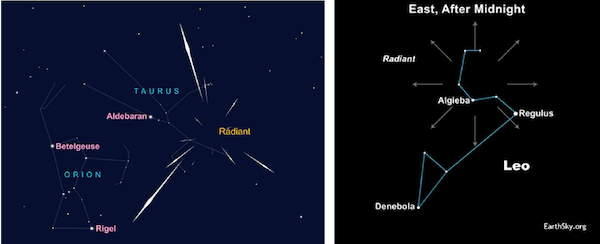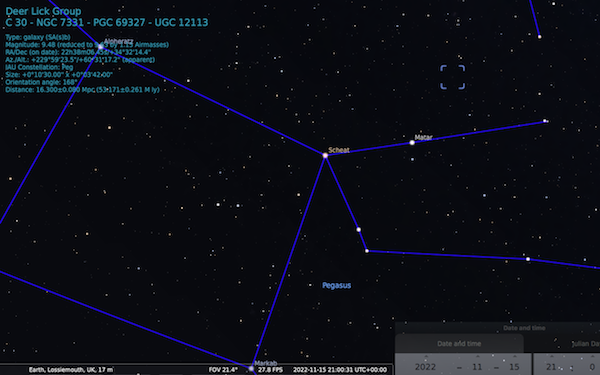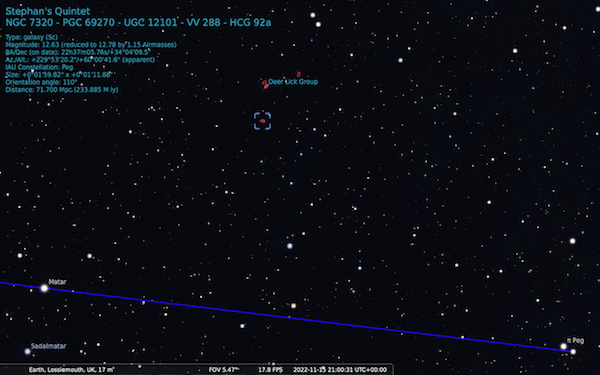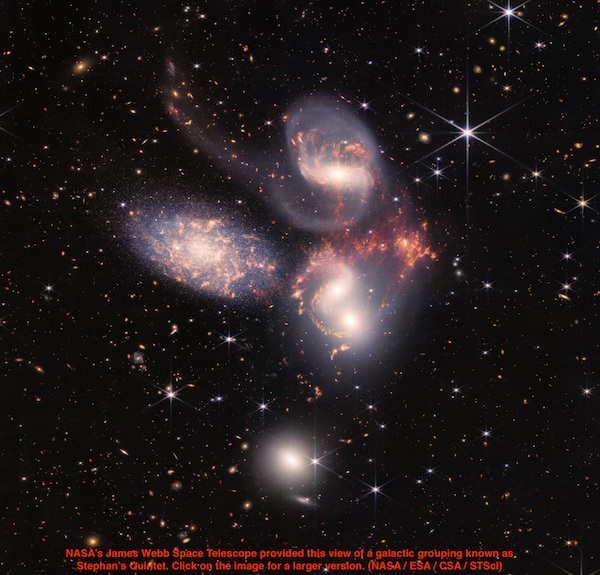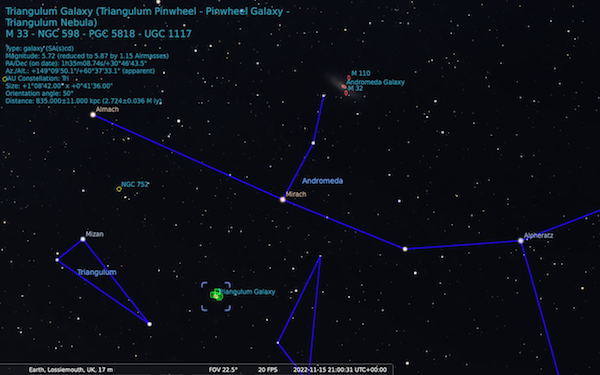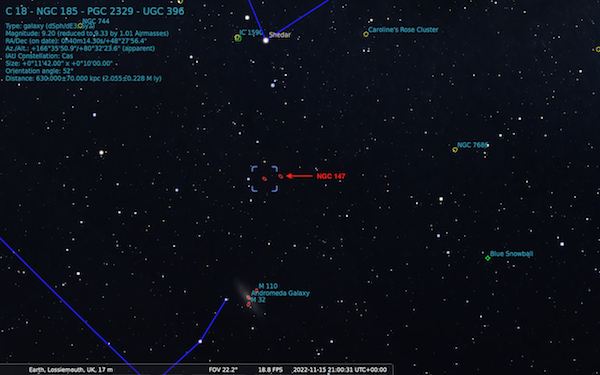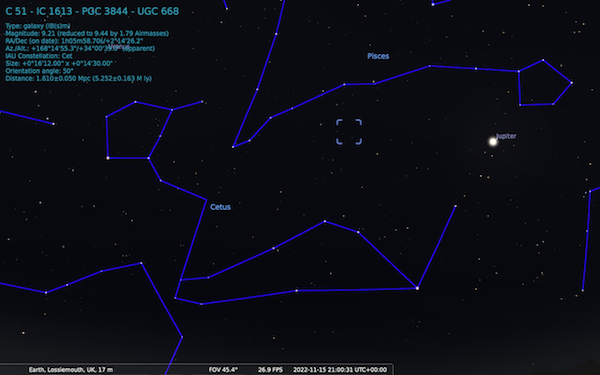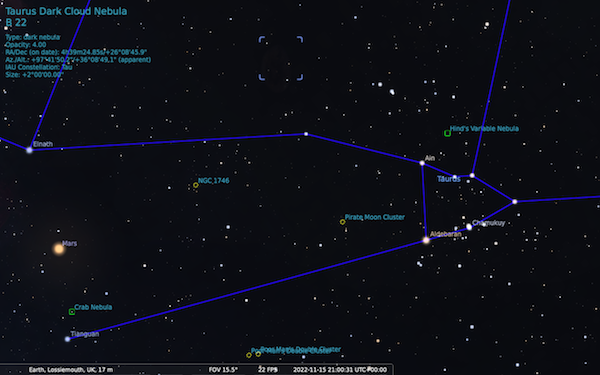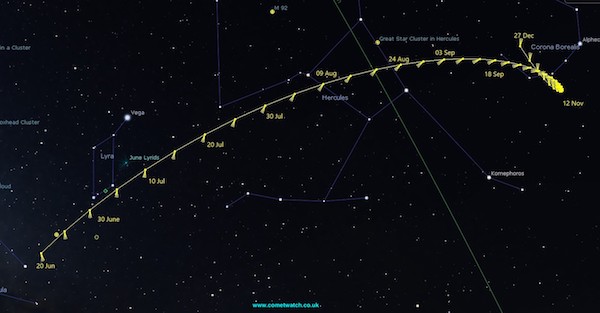Moray Sky at Night
November 2022

Moon Phases November 2022
First quarter: 1st November
Full Moon: 8th November
Last quarter: 16th November
New moon: 23rd November
First quarter: 30th November
Image courtesy of https://moonphases.co.uk
The Planets
Mercury
Comes to superior conjunction on 8th November ‘22.
Venus
Although bright,(Mag -4.0 to -3.9) it is close to the Sun and lost in the twilight.
Mars
In Taurus, brightening from Mag -1.2 to -1.8 over the month. Began retrograde motion on 31st October ’22.
Jupiter
Initially retrograding in Pisces at Mag -2.8 to -2.6, resuming direct motion on 26th November
Saturn
Moving slowly eastwards in Capricornus at Mag 0.7 to 0.8.
Uranus
In Aries at Mag 5.6, is at opposition on 9th November.
Neptune
In Aquarius at Mag 7.8 to 7.9.
MORAY’S NIGHT SKY – 15th November 2022 @21:00 hrs GMT
Thanks to Chris Peat at Heavens-above.com for use of the star map
Meteor Showers
The Northern Taurids which began mid-October, reaches maximum on 12th November, though with a low rate of about 5 meteors per hour. With a full moon on the 8th, conditions aren’t favourable. The shower gradually tails off, ending around the 10th December. There is an apparent 7-year cycle of fireball activity, but 2022 is unlikely to be a peak year.
Far more striking are the Leonids which have a relatively short period of activity (6th to 30th November), with maximum on 17/18th. This shower is associated with Comet 55P/Temple-Tuttle and on various occasions it has shown extraordinary activity with many thousands of meteors per hour. However, these high numbers have dropped dramatically over recent years and we can expect around 15 per hour in 2022. These meteors are the fastest shower meteors recorded (about 70 km per second) and often leave persistent trains. The shower is very rich in faint meteors. This year the maximum is just after last quarter, so conditions are not particularly favourable.
(Click image for larger view)
November Overview
As the nights lengthen into winter, the centre of our Milky Way galaxy dips into the south-west, and we can begin to peer out through the clearer path perpendicular to the galactic plane into the autumnal realm of galaxies.
We welcome the return of the most popular planets to the evening sky, Saturn in Capricornus and then Jupiter in Pisces, which occupy the south mid-evening. While the ringed planet remains rather low, Jupiter is now splendidly placed. Mars also becomes prominent in the east, dominating the scene by the end of the month.
The dominant signpost of this season is the Great Square of Pegasus: the large asterism that lies on the meridian at mid-evening in early November. The western stars of the Square, Scheat (beta) and Markab (alpha), point south to Aquarius and on to the most southerly first-magnitude star visible from the UK, Fomalhaut (alpha Piscis Austrini). The eastern aspect has Alpheratz (delta Pegasi, or more commonly alpha Andromedae) and Algenib (gamma Pegasi) guiding us through Pisces the fishes, to the tail of Cetus the whale, marked by Diphda (beta Ceti). But this year the scene is dominated by brilliant Jupiter, dazzling at magnitude –2.8.
Pegasus is the seventh largest constellation. The number of stars that the observer can see within the large Square is often regarded as a guide of sky transparency and light pollution. How many can you see?
Pegasus has Messier 15 (M15), a superb globular cluster to its extreme west, near the bright star Enif (epsilon Pegasi), but it is the splendid array of galaxies that attracts the deep-sky observer. The Deer Lick Group, NGC 7331 and its family group is one of the best. It is a bright spiral seen at an angle of 22 degrees, with four smaller galaxies in the field. At the currently measured distance of 45 million light-years, NGC 7331 is one of the largest spirals in our supercluster, rivalling the Andromeda Galaxy (M31). The small galaxies that seem to be associated with it are in fact much more distant background objects, being between 290 and 365 million light-years from us.
To find NGC 7331, begin with Scheat, the north-western star of the Square. To its west is Matar, eta Pegasi. A short hop to the north-west of Matar will locate this fine galaxy. In passing, the unusual ‘Deer Lick’ nickname refers to the site in North Carolina where experienced American amateur Tom Lorenzin had a particularly fine view.
Just south of NGC 7331 is an added bonus, recently made famous by the first release of images from the James Webb Space Telescope. The small group of galaxies known as Stephan’s Quintet lie a short distance south of the NGC 7331 group. NGCs 7319, 7318a, 7318b, 7317 with 7320 make up the quintet and form Hickson Compact Group 92. While four of the galaxies are at a distance of around 300 million light-years, NGC 7320 is much closer at around 40 million light-years and is possibly linked to NGC 7331.
This time of year is perfect for observing our own little family of galaxies: the so-called ‘Local Group’ that occupies a ten million light-year diameter within the supercluster. Our Milky Way and the Andromeda Galaxy (M31) dominate the group, being large spirals. The more lightweight spiral M33 (the Triangulum Galaxy) completes the spirals, the remaining 50 or so group members being dwarf elliptical or irregular galaxies, many of which are satellites of the great spirals. Several are on show through the autumn and can be fun to locate. M32 and M110 are easy targets as companions of the Andromeda spiral and are bright ellipticals; NGC 147 and 185 are also companions of M31 but lie in Cassiopeia.
They are more elusive but can be captured in the same low-power field. Sweep north-west from the Andromeda Galaxy towards Shedir (alpha Cassiopeiae) and the 10th-magnitude pair of ellipticals should be glimpsed on the most transparent nights.
November Object Challenge
A tougher target and this month’s object challenge, is IC 1613 in Cetus: a dwarf irregular that remains in pristine condition, being untouched by the bigger bullies in the group as it lies on the periphery. Although magnitude 9.9, it is 16×14 arc-minutes so is of low surface brightness.
To the east and becoming prominent as autumn deepens are the zodiacal constellations of Aries the ram and Taurus the bull. Aries has little to offer but Taurus is splendid, with its famous clusters the Hyades and Pleiades, the Crab Nebula (Messier 1), and the Taurus Dark Cloud – the nearest molecular cloud to us – with its young stars forming, notably T Tauri and Hind’s Variable nebula (NGC 1555).
This year, the bull is dominated by Mars, which ends its eastern progress to become stationary on 30th October and then begins its retrograde passage west through the horns of the bull, on its way to opposition on 8th December.
By the end of November, Orion and his retinue of brilliant winter stars are well up in the east, with Perseus at the zenith and Auriga climbing. However, Mars is likely to be a wonderful distraction over the early winter months.
Comets
As I mentioned at the October meeting, comet C/2022 E3 (ZTF) is well worth looking for and keeping an eye on.
C/2022 E3 (ZTF) is a long period comet that was discovered by the Zwicky Transient Facility on 2 March 2022. Upon discovery the comet had an apparent magnitude of 17.3 and was about 4.3 AU (640 million km) from the Sun. The object was initially identified as an asteroid, but subsequent observations revealed it had a very condensed coma, indicating it is a comet.
During October and November, it is situated in Corona Borealis and hopefully brightening steadily. It is a late evening object in October, switching to the early morning hours as we head into November.
Perihelion (when it is closest to the Sun) is on 12 January 2023; it becomes circumpolar and possibly a good binocular object.
The closest approach to Earth will be on 2 February 2023, at a distance of 0.29 AU (43 million km), by which time it is expected to become a naked-eye comet from a dark site, but as always, firm predictions of comets can always fall apart!
ISS
From 23 October until 5 November, the ISS is an morning object. Then there are no visible passes of the ISS until the 20 November, when it will be an evening object until the 6 December ’22.
For more info go to https://www.heavens-above.com/PassSummary.aspx?satid=25544
For up to date timings and maps, if you make a free account at Heavens Above and enter your location it gives you a precise timing and starmaps.
Clear Skies!
Mick

